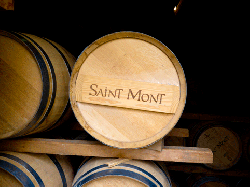 The bids are coming in thick and fast and the French auctioneer struggles to keep up; sweeping his fringe out of his eyes with one hand and waving his gavel about with the other. A thousand euros becomes two thousand and then’best of order’ has to be asked for as it hits €3000 and the crowd gasps Gallicly in astonishment.
The bids are coming in thick and fast and the French auctioneer struggles to keep up; sweeping his fringe out of his eyes with one hand and waving his gavel about with the other. A thousand euros becomes two thousand and then’best of order’ has to be asked for as it hits €3000 and the crowd gasps Gallicly in astonishment.
{youtube:4ZtTZRfNHY8}At €3050 the hammer finally comes down and Didier Vinazza, a man who rather resembles Father Dougal in a Gascon beret is surrounded by congratulations. He’s just sold a quarter barrel of his best Pacherenc for the equivalent of over €40 a bottle.
More in fact, when you consider the American buyer now has to pay the commission, the bottling, labelling and the shipping costs on top. An expensive sixty bottles of wine but definitely worth it for such nectar and the money that’s been raised will be going to good works around the area.’I took a risk harvesting in late November last year but I knew my pebbly clay terroir would be good for the Petit Manseng grapes and they were exceptional,’ Didier says above the din.
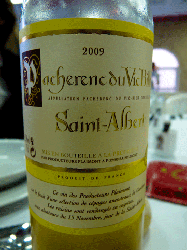 The Pacherenc auction at the Château de Crouseilles is one of the high points of the year for the Plaimont wine growers co-operative in Gers, France. Each previous year around 30 winemakers set aside small parcels of their vineyards to raise a special grape crop with 14 being judged to have produced an individual expression of Pacherenc good enough to be included in the auction (1 dry and 13 sweet).
The Pacherenc auction at the Château de Crouseilles is one of the high points of the year for the Plaimont wine growers co-operative in Gers, France. Each previous year around 30 winemakers set aside small parcels of their vineyards to raise a special grape crop with 14 being judged to have produced an individual expression of Pacherenc good enough to be included in the auction (1 dry and 13 sweet).
Since daybreak prospective buyers, have slurped and spat, met each winemaker and then had a welcome break eating the local Black Pig cured ham and drinking Jeroboams of Plaimont’s hearty red Madiran. And it’s not even 11 am yet.
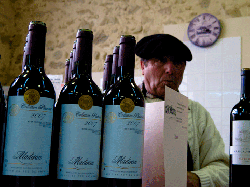 Not all that well known outside this region of France, Pacherenc, or to give it its full title, Pacherenc de Vic-Bilh is a sweet white wine, but that doesn’t really do justice to its deliciousness. Made from grapes late-harvested and which have naturally high sugar levels, it has honey and fruit on the palate and a refreshing follow through that makes it perfect for drinking with the region’s other great product – duck liver. To eat pan-fried foie gras with quince; accompanied by various Pacherencs, as we had done the previous evening, is to enter an inner circle of culinary heaven.
Not all that well known outside this region of France, Pacherenc, or to give it its full title, Pacherenc de Vic-Bilh is a sweet white wine, but that doesn’t really do justice to its deliciousness. Made from grapes late-harvested and which have naturally high sugar levels, it has honey and fruit on the palate and a refreshing follow through that makes it perfect for drinking with the region’s other great product – duck liver. To eat pan-fried foie gras with quince; accompanied by various Pacherencs, as we had done the previous evening, is to enter an inner circle of culinary heaven.
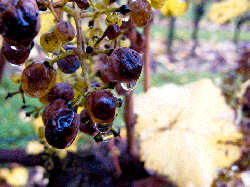 Of course to get into heaven you have to work hard. Before being allowed to eat, wine growers, wine experts and wine amateurs like myself, had cheerfully tasted a large range of Plaimont reds and whites in the Chateau de Projan‘s main reception room. Wonderful reds and stunning whites all proving that there is vibrant wine life just one and a half hour’s drive south from the more feted Bordeaux region. Over the dinner in the logis’ restaurant that followed each wine came fully alive as it partnered with Chef Richard Poullain’s fine food.
Of course to get into heaven you have to work hard. Before being allowed to eat, wine growers, wine experts and wine amateurs like myself, had cheerfully tasted a large range of Plaimont reds and whites in the Chateau de Projan‘s main reception room. Wonderful reds and stunning whites all proving that there is vibrant wine life just one and a half hour’s drive south from the more feted Bordeaux region. Over the dinner in the logis’ restaurant that followed each wine came fully alive as it partnered with Chef Richard Poullain’s fine food.
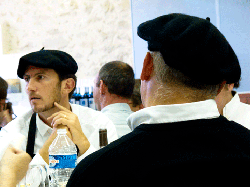 Plaimont is a cooperative producer, the name a conflation of the wine terroirs: Caves de PLaisance, Caves d’AIgnan and Cave de Saint MONT with St Mont being the defining label and over 1000 growers in all. Long hot summers, which can last late into the year, allow for mature red grapes with strong character, while cool temperatures and wet spring weather favour the whites. The passion for using native grapes and the clever matching of traditional skill with modern methods has created a wine growing behemoth of quality, consistency and respect for the land.
Plaimont is a cooperative producer, the name a conflation of the wine terroirs: Caves de PLaisance, Caves d’AIgnan and Cave de Saint MONT with St Mont being the defining label and over 1000 growers in all. Long hot summers, which can last late into the year, allow for mature red grapes with strong character, while cool temperatures and wet spring weather favour the whites. The passion for using native grapes and the clever matching of traditional skill with modern methods has created a wine growing behemoth of quality, consistency and respect for the land.
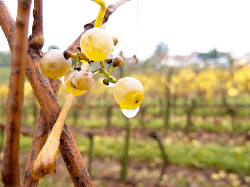 The Saint Mont whites tasted nearly all featured the Gros Manseng grape, along with Petit Courbu and Petit Manseng. Of these a bottle of Les Vignes Retrouvées 2010 showed as a fresh everyday drinking wine, with lots of pineapple and an acidity that just cried out for lobster. Another white, Le Faîte, had a bigger nose than Gerard Depardieu, a fancy wax seal and lighter acidity and was a wine that could swim with the finest fish or just partner a long rest in a sunny garden.
The Saint Mont whites tasted nearly all featured the Gros Manseng grape, along with Petit Courbu and Petit Manseng. Of these a bottle of Les Vignes Retrouvées 2010 showed as a fresh everyday drinking wine, with lots of pineapple and an acidity that just cried out for lobster. Another white, Le Faîte, had a bigger nose than Gerard Depardieu, a fancy wax seal and lighter acidity and was a wine that could swim with the finest fish or just partner a long rest in a sunny garden.
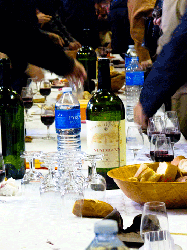 The greatest of the St Mont red grapes is Tannat, seldom if ever seen outside the region, and which varies across the Plaimont terroirs to produce distinctly different reds. It can be used alone or blended with the other unique grape of the region, the Pinenc, as well as the more widely known Cabernet Sauvignon to make reds of varying complexity but always interest and value. For me the stand out red that evening, considering its reasonable retail price, was Madiran Plénitude 2008 available at Adnams.
The greatest of the St Mont red grapes is Tannat, seldom if ever seen outside the region, and which varies across the Plaimont terroirs to produce distinctly different reds. It can be used alone or blended with the other unique grape of the region, the Pinenc, as well as the more widely known Cabernet Sauvignon to make reds of varying complexity but always interest and value. For me the stand out red that evening, considering its reasonable retail price, was Madiran Plénitude 2008 available at Adnams.
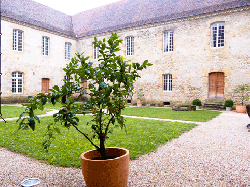 Beautifully bottled, it was 85% Tannat grape which, as the name suggests, delivered a powerful tannic grip despite the region’s use of micro-oxygenation but already tamed by the technique it should soften further over time. A big mouthful and a big wine, the 2006 Plenitude that’s now available in the UK should be an easier drink and beginning to mellow nicely.
Beautifully bottled, it was 85% Tannat grape which, as the name suggests, delivered a powerful tannic grip despite the region’s use of micro-oxygenation but already tamed by the technique it should soften further over time. A big mouthful and a big wine, the 2006 Plenitude that’s now available in the UK should be an easier drink and beginning to mellow nicely.
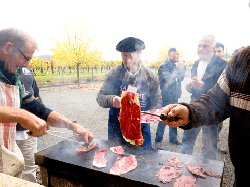 After the Pacherenc’Barrique d’Or’, or’Golden Barrel’, auction the next day we all decamped to the local village for the winemakers’ lunch, a feast which kicked off with foie gras profiteroles and great big glasses of Pacherenc, soon followed by a rich ham hock soup partnered with a Les Hauts de Bergelle Saint Mont 2009 red, a spicy wine which also went with a Gascon Shepherd’s pie of the best lamb I’ve had for ages. A great lump of Roquefort did battle with a Les Hauts de Bergelle Saint Mont 2009 white and both emerged winners
After the Pacherenc’Barrique d’Or’, or’Golden Barrel’, auction the next day we all decamped to the local village for the winemakers’ lunch, a feast which kicked off with foie gras profiteroles and great big glasses of Pacherenc, soon followed by a rich ham hock soup partnered with a Les Hauts de Bergelle Saint Mont 2009 red, a spicy wine which also went with a Gascon Shepherd’s pie of the best lamb I’ve had for ages. A great lump of Roquefort did battle with a Les Hauts de Bergelle Saint Mont 2009 white and both emerged winners
All the appellation grapes of Saint Mont are harvested by hand, often up to three times so that each individual grape is at its peak when picked. The last picking of the Pacherenc grapes takes place on December 31st, followed by a big New Year’s party.
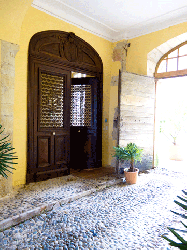 The scenery of the area is superb – from the windows of the ancient Chateau Monastere de SaintMont where I stayed; the 11th Century property of one of French TV’s top presenters, I could see the Pyrenees to the south as I ate smoked duck for breakfast in front of a roaring fire. Each room in the monastery is a beautiful testament to how the very well-off monks lived on the profits from the vineyards around, with an austerity that is also oxymoronically luxurious.
The scenery of the area is superb – from the windows of the ancient Chateau Monastere de SaintMont where I stayed; the 11th Century property of one of French TV’s top presenters, I could see the Pyrenees to the south as I ate smoked duck for breakfast in front of a roaring fire. Each room in the monastery is a beautiful testament to how the very well-off monks lived on the profits from the vineyards around, with an austerity that is also oxymoronically luxurious.
Knocked down and rebuilt several times, left to rot by its owners in the 20th century and systematically pillaged at that point for its stones by the pragmatic local villagers, it’s now very much a wonderful building once more and a remarkable B&B with optional home cooked dinners too. As you wander the corridors and peer into the courtyard it’s not hard to picture the scene as it was 500 years ago.
 Plaimont have made a speciality of rescuing run down old chateaux and manor houses and making them the focus of vineyard activity. Now buildings once roofless host dinners and tastings all year round and the maturation buildings, although state of the art inside, have been cleverly developed so as to look like just normal barns. At one stop we went into what appeared to be a farmhouse only to find a room equipped for major tastings. Here we tried more Plaimont wines, some with the reassuringly English addition to the label of the words’Marks & Spencer’, who are big Plaimont purchasers, along with Waitrose.
Plaimont have made a speciality of rescuing run down old chateaux and manor houses and making them the focus of vineyard activity. Now buildings once roofless host dinners and tastings all year round and the maturation buildings, although state of the art inside, have been cleverly developed so as to look like just normal barns. At one stop we went into what appeared to be a farmhouse only to find a room equipped for major tastings. Here we tried more Plaimont wines, some with the reassuringly English addition to the label of the words’Marks & Spencer’, who are big Plaimont purchasers, along with Waitrose.
The Gascogne Cuvée Spéciale white 2010 £5.99 M&Shad lemons and apple with a hint of herbs. The Pujalet 2010 Waitroseis made from a blend of Ugni Blanc and Colombard grapes and came across fruity and with an acidity that spoke zestily of limes not lemon.
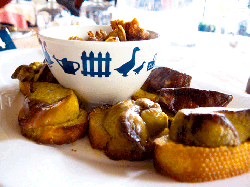 Duc de Vendôme 2010 from Waitrosemade from 60% Gros Manseng, 20% Petit Courbu, 20% Arrufiac grapes was a crisp wine, refreshingly lacking in oak, and perfect for sunny day drinking and one to partner up with a crisp salad
Duc de Vendôme 2010 from Waitrosemade from 60% Gros Manseng, 20% Petit Courbu, 20% Arrufiac grapes was a crisp wine, refreshingly lacking in oak, and perfect for sunny day drinking and one to partner up with a crisp salad
Of those left on the table, the L’Empreinte de Saint Mont white 2010 made with 80% Gros Manseng had a fine melon nose and Adnams who stock this wonderful white have the 2009 vintage white currently in store too.
A final lunch at Tomasella duck farm and restaurant in Aignan, the same farm that Vincent Labeyrie of London‘s Club Gascon gets his foie gras from, meant foie gras on baguettes for nibbles along with incredibly tasty nuggets of deep fried duck fat, followed by foie gras salad and confit Mulard duck leg. And of course more Pacherenc and Madiran.
For wine fans looking to expand out of Bordeaux and visit vineyards where tradition is respected and the wine something new to enjoy, Plaimont offers a wine trail that ends in a crock of golden Pacherenc.
Foodepedia travelled to Bordeaux airport with Easyjet and stayed at Chateau Monastere de Saint Mont, Rue Saint-Jean 32400 Saint-Mont, France about 1.5 hrs south of Bordeaux by car. There is also easy access from Pau airport. Château de Crouseilles 64350 Crouseilles Sud-Ouest FRANCE Plaimont Producteurs 32400 Saint Mont – FRANCE www.plaimont.com Plaimont wines are available at Majestic, Adnams, Waitrose and Marks & Spencers See all UK stockists of Madiran onwine–searcher, and all UK stockists of Pacherenc du Vic-Bilh onwine–searcher
